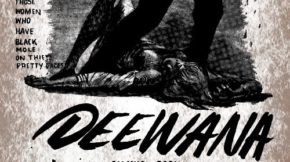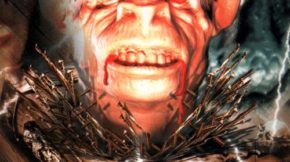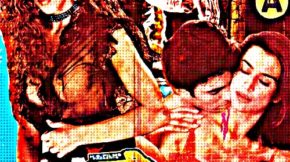After a quite sensationally cheap animated title sequence, a shot in bright sunlight of a car parked next to a big blue truck, as the door opens, suddenly from broad daylight its pitch dark! The driver, a young man with an imposing moustache, reckons the car won’t restart and that he and his sister will have to seek refuge….luckily for them, it keeps switching between daylight and darkness every few seconds, so it’s easy for them to spot a building up ahead. They are greeted by a transvestite who, for no apparent reason, proceeds to attack them with a giant claw before transforming into a slobbering demon thing. The sister screams and wakes up safely of her bed…….it was just a terrible nightmare!
However, the young Thakur (the brother) goes to the haveli to find it in a total state of disrepair. He decides that the family would be better off selling the property and investing in a hotel in the city. It seems like a sound idea, but the old chowkidar, who has been at the haveli for centuries, fears for his job even though at age 70 he doesn’t really have too much of a future ahead of him.
That night in one of the most bizarre screen murders of all, at we have the geriatric chowkidar donning the patented rubber gloves and overwhelming the youthful thakur without the slightest difficulty!
The next day, news of the murder spreads like wildfire through the city though no one seems to have any details. The editor of a cheap tabloid instructs his team to go out to Raigar to get the whole scoop while the story is still red hot. Another rival paper also sends its top-notch journalists to nab the story before anyone else. So the stage is set with plenty of youthful potential victims flocking to the old haveli at Raigar, not knowing that the most terrible fate awaits them. The rival media crew settle into the ancient haveli and get down to their investigations.
The lads among the group take a time out for some dirt bike racing, but tragedy strikes when one of the bikers heads straight for a young boy and wounds him fatally. One by one, the media team is gruesomely whittled away by a dreadful taloned creature brandishing its horrible Bhayanak Panja in the most awe-inspiring manner. The Panja manifests itself in various shapes and forms – sometimes assuming the shape of a shapely woman but with a face that looks like a vat of bubbling porridge, and once it appears as a frisky man-eating Pomeranian! Stan Winston’s creature feature Pumpkinhead is the “inspiration” for what follows as the boy’s father seeks revenge through the local witch asking her to guide him in his vengeful endeavour.
The struggle is on for survival against the deadly might of the Hideous Claw – will the group live to see another day, or will they perish horribly in the wake of another murderous assault of the Bhayanak Panja. Familiar baying wolf accompanies the movie’s opening scenes culled from the BBC’s vintage horror sounds archive (Horror Sound Effects Vol. 13). One never expects the acting to be anything but atrocious in these ultra-cheap Bollywood horror fantasies, but this time around, it defies description. It’s so shockingly abysmal. Never has a more inept cast been assembled for a film, and the lad Kumar Rajesh is beyond hideous. The script, too, is full of gems boasting stupendous exhortations like “It’s a real joke!” -this from a savvy news reporter!
Some moments are sheer brilliance suggesting that the director, R. Mittal, may yet follow in M. Night Shyamalan’s footsteps. The memorable scene where a harmless Pomeranian, happily wagging its tail, supposedly attacks a reporter is the stuff of genius. Here you have the actress, twenty times the size of the little white pooch, lifting the bewildered animal onto herself and trying desperately to make it look like the animal is ravaging her. It’s a spectacularly disastrous backfire of a scene with the dog appearing about as menacing as an ant. The poor animal is being shaken about and manhandled by the reporter. Yet, the screen fuzzes up momentarily, and upon refocusing, the audience gets to gasp in horror upon seeing what a horrible mess the dog has made out of the blood-drenched reporter. It’s a savage dog attack scene as any – with the dog as the victim, not the attacker.
There is another superb death scene where a shower supposedly coils itself around an unsuspecting bather and strangles the beauty to death. It’s another hernia inducing scene watching the actress hold the shower in position and try to appear s though she is struggling to save her life. Mamaji, who was in charge of the special effects department, has worked wonders in these scenes and created the sickeningly grotesque creature, a man with a filthy sheet thrown on top of him, but done with such charming tackiness.
Unfortunately, there are enormous doses of the most tedious comedy to put up with along the way from the retarded Birbal who, like Anil Dhawan hasn’t changed in the last 40 years. However, Mamaji’s commendable efforts aside, the film’s highlight is the dramatic appearance of a sultry femme fatale as the Tantrika, who has the nigh-impossible task of conquering the evil Panja. In a total reversal from the puny, geriatric that one has grown used to, this Tantrika is a gorgeous, buxom bombshell – Kali Calcuttaywali. She puts on a most fantastic demonstration of her mystical powers to exorcise the evil spirits and let’s face it the Panja stands little chance when faced with such a stunning seductress as a foe.
The film is a shamble from the very opening shot till the last frame. Even in a genre where one has grown accustomed to watching the most amateurish, infantile movie-making, this entity takes the cake. Never has worse acting been encountered, nor a more laughable creature – and this includes the two Pashto horror films we have had the pleasure of reviewing recently. This fantastic film manages to take a genre that is just about rock bottom, a further few incredible notches downwards plunging to the lowest depths conceivable. Bhayaanak Panjaa succeeds in making the Ramsay’s and the Bhakri’s work appear like polished big, budget works of art.
















